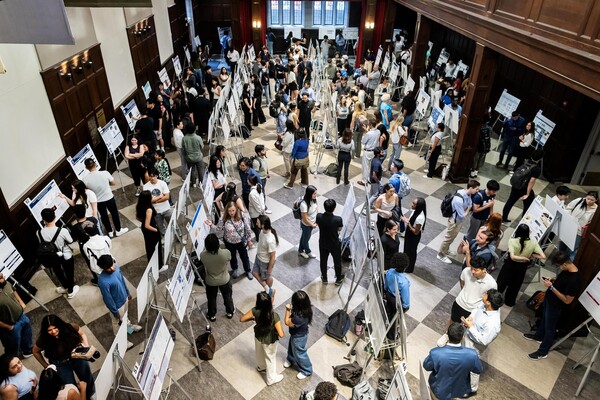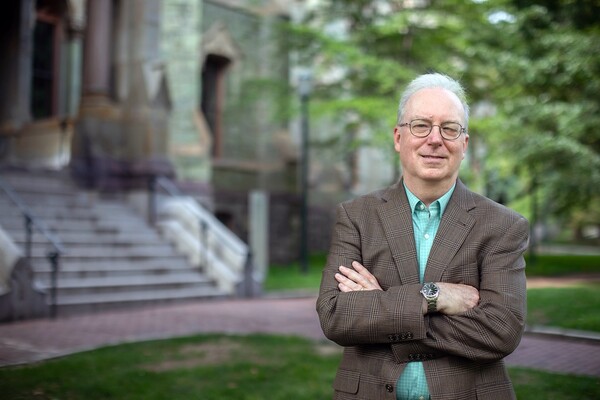
Image: Mininyx Doodle via Getty Images
In a small conference room in the basement of a hotel, four comedians, two psychologists, a cartoonist and a seven-time New Yorker caption contest winner sit around a U-shaped table.
That could be the start of a joke, especially considering who’s in the room: Bob Mankoff, then the cartoon editor for The New Yorker; Scott Dikkers, founder of The Onion; Cindy Caponera, a comedian who for two decades has written for “Saturday Night Live” and other television shows; and several other comedy professionals.
They’ve come together not to make each other laugh—though they unquestionably do—but to discuss what makes creative people creative, particularly those in their line of work.
Rounding out the group are Scott Barry Kaufman, then scientific director of the Science of Imagination Project in the University of Pennsylvania’s Positive Psychology Center; Martin Seligman, the Center’s founder and director; Elizabeth Hyde, a research specialist on the Science of Imagination Project; and Marie Forgeard, a McLean Hospital post-doctoral fellow and the project’s lead scientific consultant.
The weekend gathering is one of 11 “Imagination Retreats” the research team is holding over the course of two years on topics ranging from physics to leadership to spirituality. To date, Kaufman and colleagues have completed eight, and they expect to host the rest by August. From each comes a written report distilling overall themes, as well as a highlight video reel, all available on the Institute’s website.
So far, “we’ve learned how imagination operates in many fields and most importantly how it’s different,” Kaufman said. “That’s the point of this mission, to understand similarities and differences. What does the physicist do when he tries to imagine versus when a comedian’s trying to come up with a joke?”
It seemed the best way to do that was to bring together some of the most imaginative people they could find in each field.
“These retreats stem from domain-specific creativity, not just creative people and uncreative people,” Hyde said. “In other words, if you took someone who is creative in psychology and dropped her into physics, would she also be creative there?”
The whole idea grew out of a conversation Seligman had with Jack Templeton, the oldest son of philanthropist John Templeton. The junior Templeton approached Seligman with an idea: to give out funding in “imagination.” After some discussion, the upshot was $5.6 million from the John Templeton Foundation to go toward a grants competition for researchers to develop innovative ways of measuring and developing imagination, as well as for the discipline-specific retreats.
“The weekends have been fascinating,” Seligman said.
Pulling them together is no simple task, however. Kaufman and his team select someone they call “the magnet,” a person who is exceedingly imaginative in the particular field the team is trying to convene. The researchers then ask that person to nominate others.
For the retreat on applied math and engineering, Danielle Bassett, the Eduardo D. Glandt Faculty Fellow and a Penn associate professor of bioengineering, took on that role. Kaufman and Seligman were the magnets for education and psychology, respectively. And several other Penn researchers, including Penn Integrates Knowledge Professor Robert Ghrist and Angela Duckworth, the Christopher H. Browne Distinguished Professor of Psychology, have participated.
The goal isn’t to make these retreats about Penn, however. One centered around music and held at The Curtis Institute included two cellists from the Philadelphia Orchestra, a composer and writer and an opera librettist.
Once a group is in place, each participant is offered the chance to have a brain scan and to take a battery of computer-based tests before the retreat. They’re also given an outline of questions to guide the weekend, though more often than not, the discussions go off topic, sometimes pretty far afield.
At the neuroscience retreat, a journalist participant began repackaging the conversation he was hearing. One story stood out to Hyde: “When each person was asked, ‘Can you describe the moment you knew you wanted to be a neuroscientist?’ he responded by saying, ‘I feel like what people really told you was about their academic love life, great romances and breakups,’” she recounted. “That’s now the question we ask: Tell us about your academic love life.”
During the comedy retreat, participants spent several minutes discussing mental illness, spurred by a query from Seligman.
“Why do you think depression, unlike any other pathology, has loss of mirth?” he asked.
“It’s a good question,” said project consultant Forgeard. “There is actually loss of mirth, but at the same time a lot of people who are depressed are incredibly funny.”
“If I look at most of my friends in comedy, they’re not happy people,” said Eric Spitznagel, a writer for Men’s Health magazine. “Are they using comedy as a way of coping or are unhappy people just naturally funny?”
“There are a lot of different hypotheses,” Mankoff responded. “One is that it’s a coping mechanism. The other is that a comedy life, being funny for money, is a difficult one. Paying the rent through jokes.”
The conversation continued from there, moving onto self-deprecating humor, male versus female comedians, politics, standouts like the Marx brothers and Jerry Seinfeld and Lucille Ball. And that was all before lunch on the first day.
In general, the motivation behind each retreat and the set as a whole is to better understand creativity and imagination, how they happen, why they’re dialed up in some people and toned down in others and how they can be developed in young people. The researchers are not yet at the end of their process, so it’s hard to make any blanket statements. The same may remain true even after they finish this summer.
They’ve learned a good deal thus far. For example, inspiration tends not to come from the rational part of the brain but the more creative side, even for rational thinkers like scientists. “We have also found that the more creative you are, the harder it is to talk about your creative process,” Kaufman said. “It’s not something you think about.”
But Kaufman and his colleagues are contemplating these topics, and what they learn could unlock the key to a novel area of education or inspire future musicians or simply ensure another generation of comedians conjures up new ways to make people laugh.
Michele W. Berger

Image: Mininyx Doodle via Getty Images

nocred

Image: Pencho Chukov via Getty Images

Charles Kane, Christopher H. Browne Distinguished Professor of Physics at Penn’s School of Arts & Sciences.
(Image: Brooke Sietinsons)